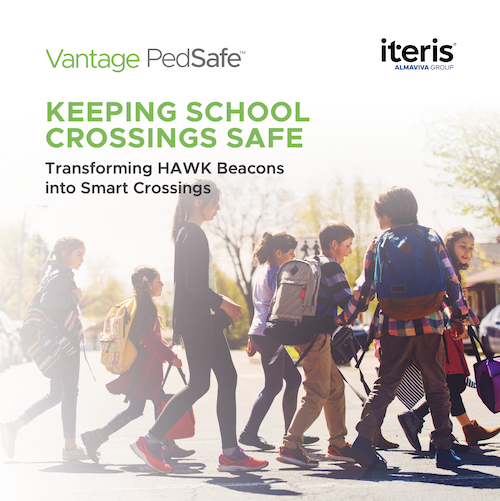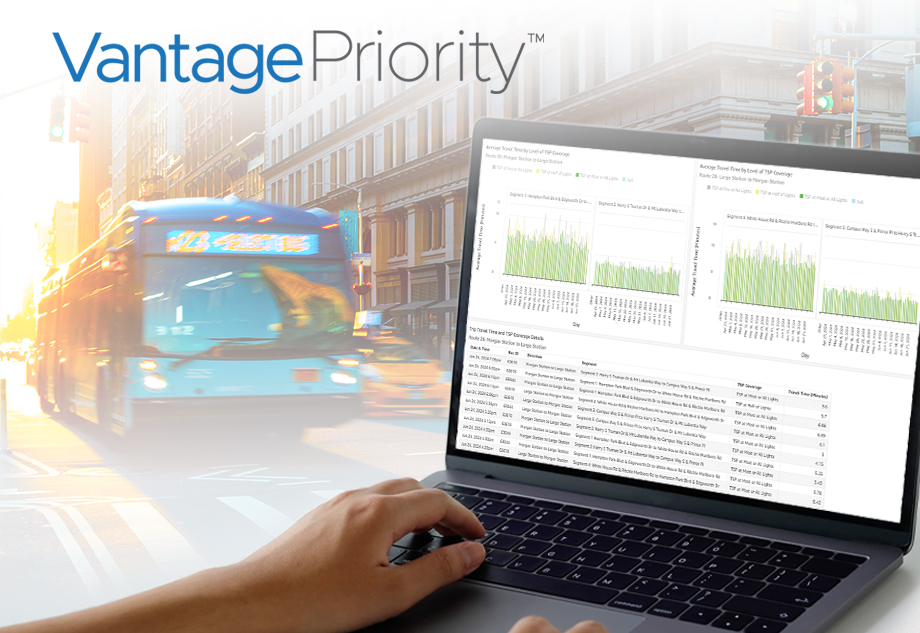
Real-Life Scenarios: How Iteris Technologies Work Together to Solve Intersection Safety Challenges

Intersections are complex environments where decisions—made by drivers, pedestrians, cyclists, and infrastructure—must align precisely to ensure safety. In part one of this blog series, we looked at the technologies that, when integrated, form powerful, real-time intersection safety solutions. Now, we’ll explore how these technologies come together in real-world scenarios to help prevent crashes, protect vulnerable road users, and give agencies the insights they need to take action.
Scenario 1: A Slower-Moving Pedestrian Needs More Time

Pedestrian clearance times are typically timed based on an assumed walking speed of 3.5 feet per second, but not all pedestrians move at that pace. In this scenario, an elderly pedestrian begins crossing during the appropriate signal phase but doesn’t reach the curb in time.
Without integrated technologies: As soon as the pedestrian interval ends, the controller initiates the next vehicle phase—risking a conflict with the pedestrian still in the crosswalk.
With Iteris technologies working together:
- Vantage PedSafe® detects the pedestrian in the crosswalk in real time and triggers roadside warnings like adaptive overhead or bollard lighting and “Pedestrian in Crosswalk” blank-out signs.
- Simultaneously, the safety alerts can be broadcast to nearby connected vehicles through V2X communications.
- The detection output also signals the traffic controller to extend the red phase for cross traffic, holding vehicles until the pedestrian reaches the curb.
- Meanwhile, ClearGuide® Safety visualizes pedestrian activity, helping agencies identify intersections that may benefit from timing adjustments or other traffic safety interventions.
 Download our illustration to see step-by-step how the above scenario is handled by Vantage PedSafe.
Download our illustration to see step-by-step how the above scenario is handled by Vantage PedSafe.
Scenario 2: A Nighttime Crossing Without a Walk Signal

Nearly 80% of pedestrian fatalities occur in low-light conditions, and many intersections see pedestrians cross without activating pushbuttons. In this scenario, a pedestrian steps into a crosswalk at night without a ‘Walk’ indication. A vehicle is making a legal left turn.
Without integrated technologies: The driver may not see the pedestrian in time, leading to a near-miss or worse.
With Iteris technologies working together:
- Vantage PedSafe identifies the pedestrian despite the darkness.
- That detection triggers multiple safety responses: illuminated overhead lighting or bollards brighten the crosswalk, blank-out signs alert drivers, and connected vehicles are notified via roadside units.
- In more advanced deployments, AI algorithms running on Iteris’ in-cabinet processor can even predict a possible collision based on the vehicle’s path and speed—prompting an increase in overhead lighting or bollard brightness to get everyone’s attention.
- All of this is recorded in ClearGuide, which flags the incident for review and analysis.
 Download our illustration to see step-by-step how the above scenario is handled by Vantage PedSafe.
Download our illustration to see step-by-step how the above scenario is handled by Vantage PedSafe.
Scenario 3: Red-Light Runner Threatens a Pedestrian

Red-light running is a leading cause of fatal crashes at intersections. In this scenario, a visually impaired pedestrian is waiting on the curb for a ‘Walk’ indication/tone, while a vehicle is approaching fast and likely to run the red.
Without integrated technologies: The ‘Walk’ tone would activate as usual, encouraging the pedestrian to step off the curb just as the vehicle enters the intersection illegally.
With Iteris technologies working together:
- Vantage Vector® detects the vehicle’s speed and trajectory in real time, and the Vantage Apex® processor uses this data to predict a red-light runner and sends a hold command to the traffic controller, delaying the ‘Walk’ signal and southbound green phase.
- At the same time, Vantage PedSafe illuminates the pedestrian at the curb to make them more visible to the driver. A warning is broadcast to nearby connected vehicles.
- The integrated system prevents a potentially fatal crash before it can happen—and logs the red-light running event in ClearGuide for frequency or severity analysis.
Scenario 4: Students at Risk in School Zone Crossings

Mid-block crossings near schools often rely on traditional High-Intensity Activated Crosswalks (HAWKs), which use fixed timing and pushbutton activation. But these systems can’t adapt to real-world conditions like poor lighting, speeding vehicles, or obstructed sightlines caused by curves, trees, or parked cars—leaving students vulnerable.
Without integrated technologies: Standard HAWK beacons activate only when a pedestrian presses the button, and the preset timing may not be long enough for all pedestrians to cross safely—especially during high-traffic school hours or special events.
With Iteris technologies working together:
- Vantage PedSafe transforms a traditional HAWK into a Smart HAWK, using radar to detect pedestrians in real time—even if they don’t press the button—and immediately activates the beacon flashers.
- If pedestrian presence exceeds a user-defined threshold, adaptive flashing keeps the lights on until the crosswalk is clear, ensuring no one is left behind.
- Connected vehicle alerts are broadcast via roadside units, warning approaching drivers of pedestrian activity ahead.
- In low-light or obstructed conditions, illuminated bollards or overhead lighting enhance visibility for both pedestrians and drivers.
- All pedestrian activity is logged in ClearGuide, enabling agencies to analyze crossing patterns and optimize signal timing or infrastructure improvements.
 Download our illustration to see step-by-step how the above scenario is handled by Vantage PedSafe.
Download our illustration to see step-by-step how the above scenario is handled by Vantage PedSafe.
Bringing It All Together in the Field
These aren’t just hypothetical situations. Iteris has already helped agencies implement these coordinated safety measures in the following regions and beyond:
- Coachella Valley, CA: Over 130 intersections upgraded with Iteris’ Vantage Apex with Vantage Vector and analytics solutions across multiple jurisdictions. Vantage Apex was chosen because of the quality of detection and data available including counts, trends, and AI classification abilities.
- City of Irving, TX: Adopted Iteris Vantage Vector as the standard detection sensor for 220 intersections citywide, based on its wide feature set, including speed-sensitive radar, and its ease of setup.
- VDOT’s SmarterRoads Initiative: Iteris designed, developed, and deployed VDOT’s statewide, cloud-based SmarterRoads data portal, enabling real-time data sharing and enhancing transparency and innovation for connected vehicle applications. VDOT envisions the SmarterRoads data portal as the go-to source for CV data sharing; the portal is already integrating real-time signal timing data from 1,000 traffic signal controllers as well as SPaT and MAP data from Virginia’s Connected Corridor’s pilot project.
A Smarter, Safer Path Forward
Improving intersection safety is about more than any one sensor, algorithm, or signal. It’s about bringing the right tools together to sense danger, take real-time action, and help agencies make informed, proactive decisions. From slowing down vehicles to protecting vulnerable road users, Iteris’ integrated technologies are already delivering results on the ground—and helping shape the future of safer, smarter intersections.
To learn more about our real-world deployments and how your agency can benefit, contact our team today. And, if you missed part one of this series, make sure to check it out here.
See for yourself how Vantage PedSafe protects vulnerable road users — watch our recent webinar.
About the Author

Breanna Wallace is manager of public relations and social media at Iteris.
Connect with Breanna Wallace on LinkedIn
 X
(Twitter)
X
(Twitter)
 Facebook
Facebook LinkedIn
LinkedIn Copy
Link
Copy
Link Email
Email

